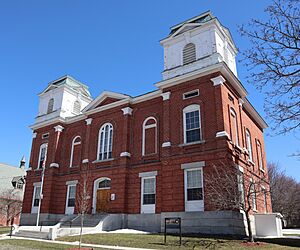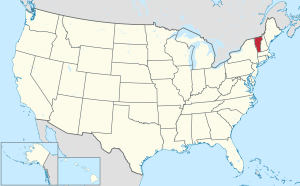Franklin County, Vermont facts for kids
Quick facts for kids
Franklin County
|
|
|---|---|

Franklin County Court House in St. Albans
|
|

Location within the U.S. state of Vermont
|
|
 Vermont's location within the U.S. |
|
| Country | |
| State | |
| Founded | December 1, 1796 |
| Named for | Benjamin Franklin |
| Shire Town | St. Albans |
| Largest city | St. Albans |
| Area | |
| • Total | 692 sq mi (1,790 km2) |
| • Land | 634 sq mi (1,640 km2) |
| • Water | 58 sq mi (150 km2) 8.4%% |
| Population
(2020)
|
|
| • Total | 49,946 |
| • Density | 72.18/sq mi (27.867/km2) |
| Time zone | UTC−5 (Eastern) |
| • Summer (DST) | UTC−4 (EDT) |
| Congressional district | At-large |
Franklin County is a county located in the U.S. state of Vermont. As of the 2020 census, the population was 49,946. Its county seat is the city of St. Albans. It borders the Canadian province of Quebec. The county was created in 1792 and organized in 1796. Franklin County is part of the Burlington metropolitan area.
Contents
History
Franklin County is one of several Vermont counties created from land claimed by Vermont on January 15, 1777, when Vermont declared itself to be a state distinct from New York. The land originally was contested by Massachusetts, New Hampshire, and New York, but it remained undelineated until July 20, 1764, when King George III established the boundary between New Hampshire and New York along the west bank of the Connecticut River, north of Massachusetts and south of the parallel of 45 degrees north latitude. New York assigned the land gained to Albany County. On March 12, 1772, Albany County was partitioned to create Charlotte County, and this situation remained until Vermont's independence from New York and Britain. However, this did not end the contest. In 1772, land surveyors John Collins of Quebec and Thomas Valentine of New York erected survey monuments along what they took to be the 45th parallel of north latitude, intended to be the boundary between New York and Quebec. The Webster–Ashburton Treaty of 1842 said that their measurement errors stand, so the boundary between Vermont and Quebec, and between New York and Quebec, is where Collins and Valentine put the survey monuments, some of which still stand today (see Collins–Valentine line).
On September 3, 1783, as a result of the signing of the Treaty of Paris the Revolutionary War ended with Great Britain recognizing the independence of the United States. Article II of the treaty agreed on boundaries between the United States and British possessions to the north, and included Vermont within the U.S. Vermont's border with Quebec was established at 45 degrees north latitude. In 1792, Franklin County was formed from part of Chittenden County. However, Vermont's government continued to take the position that it was independent of both the United States and Britain, and so it remained until 1791.
The county's namesake is Benjamin Franklin. Chester A. Arthur, the 21st U.S. President, was born in the town of Fairfield. He was one of two Presidents to be born in the state, the other being Calvin Coolidge.
In 2008, the federal government declared the county a disaster area after severe storms and flooding on June 14–17.
Geography
According to the U.S. Census Bureau, the county has an area of 692 square miles (1,790 km2), of which 634 square miles (1,640 km2) is land and 58 square miles (150 km2) (8.4%) is water.
Adjacent counties and municipalities
- Orleans County – east
- Lamoille County – southeast
- Chittenden County – southwest
- Grand Isle County – west
- Le Haut-Richelieu Regional County Municipality, Quebec – northwest
- Brome-Missisquoi Regional County Municipality, Quebec – north
National protected area
Demographics
| Historical population | |||
|---|---|---|---|
| Census | Pop. | %± | |
| 1800 | 8,282 | — | |
| 1810 | 16,615 | 100.6% | |
| 1820 | 17,192 | 3.5% | |
| 1830 | 24,525 | 42.7% | |
| 1840 | 24,531 | 0.0% | |
| 1850 | 28,586 | 16.5% | |
| 1860 | 27,231 | −4.7% | |
| 1870 | 30,291 | 11.2% | |
| 1880 | 30,225 | −0.2% | |
| 1890 | 29,755 | −1.6% | |
| 1900 | 30,198 | 1.5% | |
| 1910 | 29,866 | −1.1% | |
| 1920 | 30,026 | 0.5% | |
| 1930 | 29,975 | −0.2% | |
| 1940 | 29,601 | −1.2% | |
| 1950 | 29,894 | 1.0% | |
| 1960 | 29,474 | −1.4% | |
| 1970 | 31,282 | 6.1% | |
| 1980 | 34,788 | 11.2% | |
| 1990 | 39,980 | 14.9% | |
| 2000 | 45,417 | 13.6% | |
| 2010 | 47,746 | 5.1% | |
| 2020 | 49,946 | 4.6% | |
| U.S. Decennial Census 1790–1960 1900–1990 1990–2000 2010–2018 |
|||
2010 census
As of the 2010 United States Census, there were 47,746 people, 18,513 households, and 12,939 families residing in the county. The population density was 75.3 inhabitants per square mile (29.1/km2). There were 21,588 housing units at an average density of 34.1 per square mile (13.2/km2). Of the 18,513 households, 34.9% had children under the age of 18 living with them, 53.7% were married couples living together, 10.7% had a female householder with no husband present, 30.1% were non-families, and 22.7% of all households were made up of individuals. The average household size was 2.55 and the average family size was 2.97. The median age was 39.6 years.
The median income for a household in the county was $53,623 and the median income for a family was $63,009. Males had a median income of $43,155 versus $36,940 for females. The per capita income for the county was $24,767. About 7.2% of families and 10.5% of the population were below the poverty line, including 13.8% of those under age 18 and 8.7% of those age 65 or over.
Economy
Personal income
The median income for a household in the county was $41,659, and the median income for a family was $46,733. Males had a median income of $32,009 versus $24,078 for females. The per capita income for the county was $17,816. About 7.00% of families and 9.00% of the population were below the poverty line, including 10.40% of those under age 18 and 10.30% of those age 65 or over.
Industry
In 2009, the county had the most dairy farms in the state, 239 out of 1,078.
Communities
City
Towns
Villages
Villages are census divisions, but have no separate corporate existence from the towns they are in.
- Enosburg Falls – village of Enosburgh
- Swanton Village – village of Swanton
Census-designated places
- Bakersfield
- Fairfax
- Highgate Center
- Highgate Springs
- Richford
See also
 In Spanish: Condado de Franklin (Vermont) para niños
In Spanish: Condado de Franklin (Vermont) para niños

